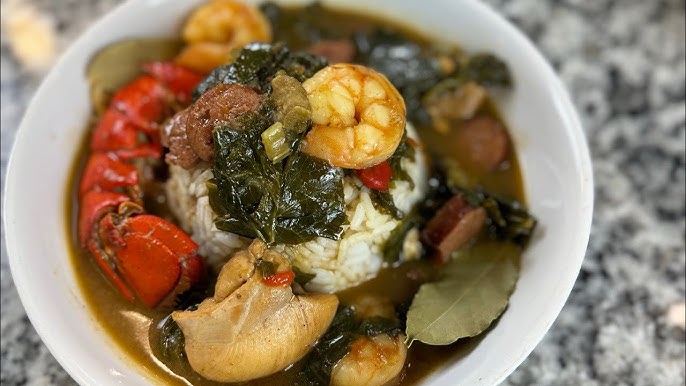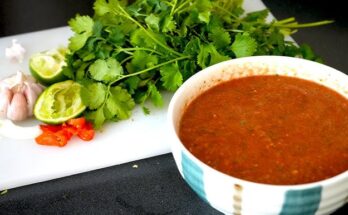Gumbo Greens Recipe: If you’ve ever had a bowl of rich, flavorful gumbo or a pot of tender, smoky greens, imagine combining both into one soul-soothing dish. That’s exactly what Gumbo Greens is all about. It’s the lovechild of two Southern staples: hearty greens and the savory stew-like goodness of gumbo. The result? A comforting, deeply satisfying meal that warms you from the inside out. Whether you’re cooking for Sunday dinner or just want something cozy during a rainy day, this dish delivers on flavor and tradition.
Born from the culinary melting pot of the American South, Gumbo Greens is more than just a recipe—it’s a celebration of culture, creativity, and comfort food at its best. We’re walking you through every step, from selecting the best greens to building layers of flavor like a true Southern chef. Ready to impress your family (and yourself)? Let’s get cooking.
What Are Gumbo Greens?
Gumbo Greens is a beautiful fusion of two Southern powerhouses: the robust depth of gumbo and the earthy comfort of slow-cooked greens. It’s not quite a stew and not quite a side—it’s a dish that stands on its own. Picture mustard greens, collard greens, or turnip greens swimming in a savory, smoky, sometimes spicy broth, often thickened with a dark roux or okra. Toss in some smoked meat or spicy sausage, and you’ve got yourself a meal that’s both bold and balanced.
While traditional gumbo hails from Louisiana and typically includes seafood or chicken with okra or filé powder, Gumbo Greens puts leafy vegetables in the spotlight. This twist has its roots in soul food kitchens across the South, where resourcefulness and flavor go hand in hand. It’s comfort food elevated—soulful, bold, and rich in history.
Health Benefits of Gumbo Greens
Don’t let the comfort-food label fool you—Gumbo Greens can actually be incredibly good for you. The leafy greens used in this dish (like collards, mustard, and turnip greens) are nutritional powerhouses. They’re packed with vitamins A, C, and K, along with calcium, iron, and fiber. These nutrients help support a healthy immune system, bone health, and digestion.
When cooked with lean meats or made entirely vegetarian, Gumbo Greens becomes a wholesome, low-carb meal loaded with antioxidants and anti-inflammatory properties. Even the spices used—like cayenne pepper, garlic, and onion—have immune-boosting benefits. Plus, greens are low in calories, which makes this dish perfect for anyone watching their weight but still craving that deep, satisfying Southern flavor.
Looking for heart health, energy, and comfort in one pot? You’ve found it.
Ingredients You’ll Need
Before you jump into cooking, let’s take a close look at what you’ll need. You can always tweak it depending on dietary needs or what’s available at your local grocery store.
Greens (choose a mix or just one type):
- 1 bunch collard greens
- 1 bunch mustard greens
- 1 bunch turnip greens
- (Optional: kale or spinach for a milder bite)
Aromatics (the Holy Trinity):
- 1 large onion, chopped
- 1 green bell pepper, chopped
- 2 celery stalks, chopped
Flavor Boosters:
- 4 garlic cloves, minced
- 1 tablespoon Cajun seasoning
- 1 teaspoon smoked paprika
- ½ teaspoon cayenne pepper (adjust to taste)
- Salt and black pepper to taste
- 1 teaspoon dried thyme
Meats (optional but recommended for deep flavor):
- 1 smoked turkey leg or wing
- 1/2 pound andouille sausage, sliced
- (Optional: ham hocks, bacon, or even shrimp)
Liquid:
- 4 cups chicken broth or vegetable broth
- 2 cups water
- 1 tablespoon apple cider vinegar (for brightness)
Thickening Agents:
- ¼ cup all-purpose flour (for roux)
- ¼ cup vegetable oil or bacon grease
- (Optional: 1 cup sliced okra as a thickener)
Extras:
- Hot sauce (to serve)
- Cooked white rice or cornbread (on the side)
This list may look long, but trust me, it’s all about layering flavor. Each ingredient brings something important to the party.
Kitchen Tools & Equipment
To make Gumbo Greens like a pro, you don’t need a fancy setup—just a few reliable kitchen tools that make the process smooth and efficient. Here’s what you’ll want to have on hand:
Essential Tools:
- Large Stockpot or Dutch Oven: This is your main player. You’ll need something heavy-bottomed to retain and distribute heat evenly. Cast iron or enameled Dutch ovens are perfect.
- Sharp Chef’s Knife: You’ll be chopping a lot—onions, peppers, celery, and greens. A good knife makes the process faster and safer.
- Cutting Board: Preferably two—one for meat and one for veggies to avoid cross-contamination.
- Wooden Spoon or Silicone Spatula: Ideal for stirring the roux and scraping up flavorful bits from the bottom of the pot.
- Measuring Cups & Spoons: Precision matters when balancing bold Southern spices.
- Strainer or Salad Spinner: Cleaning greens thoroughly is crucial. A salad spinner saves loads of drying time.
- Ladle: Makes serving your gumbo greens easier and less messy.
Optional but Helpful:
- Slow Cooker: If you want a more “set it and forget it” approach, you can adapt this recipe to a slow cooker after the initial sautéing.
- Immersion Blender: If you want a smoother base without losing texture, blending just part of the soup can be a game changer.
Having the right tools doesn’t just make cooking easier—it elevates the final dish. Gumbo Greens deserve that kind of love.
Preparation Tips Before You Start
Before you crank up the heat, do yourself a favor—prep everything. A little mise en place (a fancy French way of saying “everything in its place”) can mean the difference between a fun cooking experience and total kitchen chaos.
1. Wash Those Greens Like a Pro
Southern greens are often sandy or gritty, so rinse them thoroughly—at least 2–3 times in cold water. Use a salad spinner if you’ve got one. Grit in your gumbo greens? Big no-no.
2. Remove Tough Stems
Especially for collard greens, the stems can be too tough to eat comfortably. Fold the leaf in half and slice the stem out, then chop the leaves into bite-sized pieces.
3. Chop Everything Beforehand
Dice your onions, celery, and bell pepper, and slice up that sausage. You don’t want to be racing against the clock once things are sizzling.
4. Measure Out Your Spices
Mix your spices in a small bowl ahead of time. That way, you can dump them in all at once instead of scrambling to remember if you already added the thyme or not.
5. Warm the Broth
This step isn’t mandatory, but warming your broth slightly helps keep the cooking process smooth once you add it to the pot. Cold broth can drop the temperature and slow things down.
6. Set Up a Roux Station
If you’re making a roux, have the oil and flour measured out and a whisk or spatula ready. Once that oil heats up, you’ve got to move quickly and stir constantly.
Once your prep is done, it’s go time—and trust me, you’ll feel like a kitchen boss with everything ready to roll.
Step-by-Step Guide to Making Gumbo Greens
Here’s where the magic happens. Follow these detailed steps, and you’ll end up with a pot of Gumbo Greens that’s rich, bold, and soul-warming.
Step 1: Prepping the Greens
Wash collard, mustard, or turnip greens thoroughly to remove grit. Trim thick stems and chop the leaves into bite-sized pieces. Set aside to dry slightly.
Step 2: Sautéing the Holy Trinity
In a large pot, heat oil or butter. Sauté chopped onions, celery, and bell pepper—the classic “holy trinity”—until soft and fragrant. Add minced garlic for extra depth.
Step 3: Adding Seasonings & Spices
Stir in smoked paprika, thyme, cayenne, salt, and pepper. Add smoked sausage or ham hocks if you want traditional smoky flavor.
Step 4: Making the Roux (Optional)
For a thicker, richer stew, make a light roux by mixing flour and oil in the pot until golden. This step enhances gumbo-style texture.
Step 5: Simmering Everything Together
Add the chopped greens and cover with broth. Bring to a boil, then reduce heat and simmer for 45–60 minutes until tender and flavorful.
Step 6: Finishing Touches
Adjust seasoning, add hot sauce if desired, and serve warm with cornbread or rice. Enjoy your hearty gumbo greens!
How to Make a Flavorful Roux
The roux is one of those things that seems intimidating until you try it—and then you wonder how you ever cooked without it. It’s simply a mix of fat and flour, but when cooked low and slow, it transforms into a nutty, deep, flavor-packed base that gives your gumbo greens a signature richness.
Light vs. Dark Roux:
- Light Roux: Cooks for 3–5 minutes. Pale, mild, and good for thickening.
- Medium Roux: Cook for 8–10 minutes until peanut butter-colored. Slightly nutty.
- Dark Roux: Cook 12–15 minutes until deep brown. Most flavorful and traditional in gumbo.
For gumbo greens, we recommend going medium to dark. Use equal parts flour and fat (like bacon grease, butter, or oil). Stir constantly over medium heat. Once you smell that nutty, almost popcorn-like aroma, you’re there.
Tips to Avoid Burning:
- Never walk away—seriously, it burns fast.
- Use a heavy-bottomed skillet or Dutch oven.
- Adjust the heat if you see dark specks—those are signs of burning.
If it burns? Toss it and start over. A burnt roux will ruin the whole pot. But when done right, it adds soul to your gumbo greens like nothing else.
Common Mistakes to Avoid
Gumbo Greens is a forgiving dish, but a few missteps can hold it back from greatness. Here’s how to sidestep the most common errors:
1. Overcooking the Greens
Don’t let your greens turn to mush. You want them tender, not limp. Simmer them until they’re soft but still have a little structure—usually around 45 minutes to an hour.
2. Skipping the Roux
It may seem like an extra step, but the roux adds depth you can’t fake. Even just a light roux can make a big difference.
3. Not Seasoning in Layers
Add spices in stages—not just at the end. Layering flavor is the secret to great Southern cooking.
4. Not Using the Holy Trinity
That onion, celery, and bell pepper combo? Don’t skip it. It’s the aromatic base that ties everything together.
5. Too Much Salt Too Soon
Especially if you’re using smoked meats or broth, salt can sneak up on you. Taste often and adjust gradually.
Avoid these, and your gumbo greens will taste like something from your grandma’s kitchen (if she cooked Southern food).
Customization Tips
One of the best things about gumbo greens is how flexible the recipe is. Whether you’re feeding vegetarians, meat lovers, or spice wimps, you can tweak this dish to suit anyone.
For a Vegetarian/Vegan Version:
- Use vegetable broth instead of chicken.
- Skip the roux or make it with plant-based butter or oil.
- Add mushrooms, okra, or smoked tofu for richness.
- Smoked paprika helps mimic the flavor of smoked meat.
For Meat Lovers:
- Smoked turkey wings, ham hocks, or sausage are classic.
- For extra depth, sauté some bacon at the beginning and use the fat for your roux.
- Mix in shredded chicken or even shrimp near the end of cooking.
Adjusting the Heat:
- Keep it mild with just paprika and black pepper.
- Add cayenne, jalapeños, or your favorite hot sauce for spice lovers.
Want it Extra Thick?
- Simmer uncovered to reduce liquid.
- Add more roux or chopped okra.
Gumbo greens are made to fit your kitchen, your pantry, and your tastebuds. Don’t be afraid to experiment.
Best Sides to Serve with Gumbo Greens
This dish is bold enough to stand on its own, but pairing it with the right side can turn it into a showstopper of a meal.
1. Cornbread
Buttery, slightly sweet cornbread is the classic. It soaks up all that flavorful broth and adds texture. Bonus points if it’s skillet-baked.
2. White or Brown Rice
Rice balances the richness of the greens. Ladle the gumbo greens over a warm bed of rice for the ultimate Southern comfort combo.
3. Potato Salad (Yes, Really!)
In some Southern households, potato salad is served right in the gumbo. It’s creamy, cool, and contrasts beautifully with the heat.
4. Hot Sauce
Not exactly a side, but essential. Try different types like Louisiana-style, Tabasco, or even a smoky chipotle sauce.
5. Fried Okra or Sweet Potatoes
Crispy or caramelized sides offer texture and sweetness to balance the savory gumbo greens.
Serve your Gumbo Greens like a pro, and your guests will be begging for seconds.
How to Store and Reheat Leftovers
Gumbo Greens isn’t just good on day one—it might even be better the next day. Like most slow-cooked Southern dishes, the flavors deepen and marry overnight. So don’t be afraid to make a big batch. Here’s how to keep those leftovers tasting fresh and delicious.
Storing in the Fridge:
- Cool it first: Let your gumbo greens come to room temperature before storing. This prevents condensation, which can water down the flavor.
- Use airtight containers: Glass or BPA-free plastic containers with a tight seal are your best bet.
- Shelf life: Gumbo greens can be stored in the fridge for up to 4–5 days.
Freezing Tips:
- Portion it out: Use freezer-safe containers or heavy-duty freezer bags. Label them with the date.
- Leave room for expansion: Liquids expand when frozen. Don’t overfill.
- Freeze for up to 3 months: While it can last longer, the texture of greens is best if consumed within this window.
Reheating:
- Stovetop method: Reheat in a pot over low-medium heat. Add a splash of broth or water to loosen it up.
- Microwave: Use a microwave-safe bowl, cover loosely, and heat in intervals, stirring between rounds.
- Avoid boiling: Boiling can make the greens mushy. Keep it at a gentle simmer or medium heat.
Pro tip: Always taste after reheating. Sometimes, a little fresh hot sauce, vinegar, or seasoning brings it back to life.
Can You Make Gumbo Greens Ahead of Time?
Absolutely—and you should. Gumbo Greens is one of those rare dishes that actually improves the longer it sits. Making it ahead not only saves time but enhances flavor in a way that same-day cooking just can’t match.
Make-Ahead Benefits:
- Deeper flavor: Letting the dish sit overnight gives the spices time to mellow and mingle.
- Stress-free serving: Cook it the night before a big meal or party and just reheat.
- Meal prep made easy: Portion it into containers for quick, grab-and-go lunches or dinners all week.
Tips for Advance Prep:
- Cook completely, then cool before storing.
- Store in glass containers to preserve flavor and reduce staining.
- Wait to add delicate garnishes like fresh herbs or green onions until serving.
You can even make a big pot and freeze half for a future dinner you’ll actually look forward to. Your future self will thank you.
Serving Suggestions and Presentation
Presentation might not seem important when it comes to soul food, but hey—we eat with our eyes first. And let’s be real: a bowl of greens and broth can look a little, well, monochrome if you’re not intentional. Here’s how to dress up your dish without overcomplicating it.
Serving Vessels:
- Big, shallow bowls: Perfect for showcasing those rich greens and smoky broth.
- Rustic cast-iron skillets: Great for family-style dining—just place on the table and let folks dig in.
- Mini cast-iron pots: Individual servings with Southern charm.
Garnish Like a Pro:
- Fresh green onions or parsley: Adds a pop of color and freshness.
- Crumbled bacon: A crunchy, salty topper.
- Red pepper flakes or hot sauce swirl: For spice and style.
Pair it Right:
- Serve with a scoop of rice or cornbread right in the bowl.
- A drizzle of good olive oil or garlic oil gives it a restaurant-quality feel.
- Pickled onions or peppers add brightness and cut through the richness.
Even if you’re just cooking for yourself, a well-plated bowl of gumbo greens makes the experience feel special. And let’s be honest—after putting all that love into your cooking, it deserves to look as good as it tastes.
FAQs about Gumbo Greens Recipe
1. Can I make Gumbo Greens without meat?
Yes, you can absolutely go meatless! Use vegetable broth and smoked paprika or liquid smoke to mimic that smoky depth. Add mushrooms, tofu, or beans for extra protein.
2. What type of greens work best?
Collard, mustard, and turnip greens are classic. You can also use kale or even a bit of spinach if you want to mellow the flavor. A mix offers the best texture and taste.
3. How spicy is this dish?
It depends on how much cayenne or hot sauce you add. Start mild and build the heat gradually. Want no spice? Skip the cayenne. Love it hot? Go wild.
4. Can I freeze Gumbo Greens?
Yes! Let the dish cool, then portion it into freezer-safe containers. It freezes well for up to 3 months. Reheat gently on the stove for best texture.
5. Do I need to add okra?
Not necessarily. Okra is a traditional gumbo thickener and adds a nice texture, but if you’re not a fan, you can skip it or use roux instead for thickness.
Final Thoughts
Gumbo Greens is more than just a Southern staple—it’s a dish packed with soul, heritage, and heart. It brings together the bold flavors of gumbo with the nutritional powerhouse of leafy greens, creating a comforting, wholesome meal that speaks to the soul.
Whether you’re cooking for Sunday dinner, prepping for the week, or introducing someone to Southern cuisine, this recipe delivers. With smoky meats, savory spices, and a warm, rich broth, it hits every flavor note. And the best part? It’s flexible enough to make your own. Vegan? No problem. Spicy? Easy. Need to stretch a dollar? These greens have got your back.
So grab a pot, roll up your sleeves, and let the scent of simmering gumbo greens fill your kitchen. One bowl and you’ll know—this dish is Southern hospitality in edible form.



